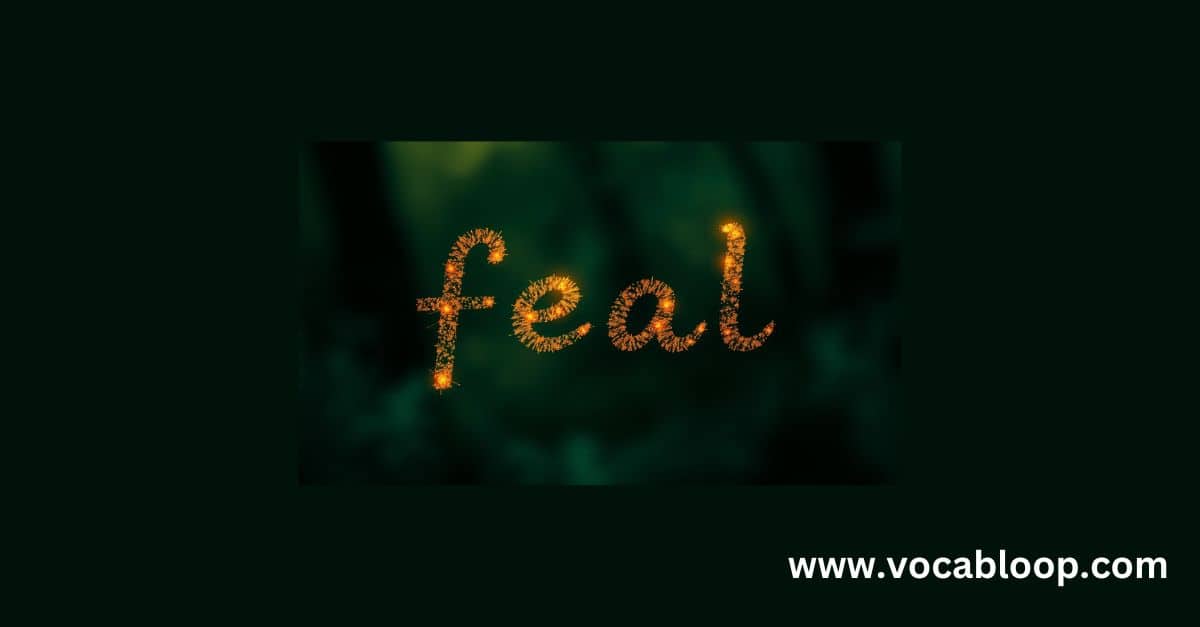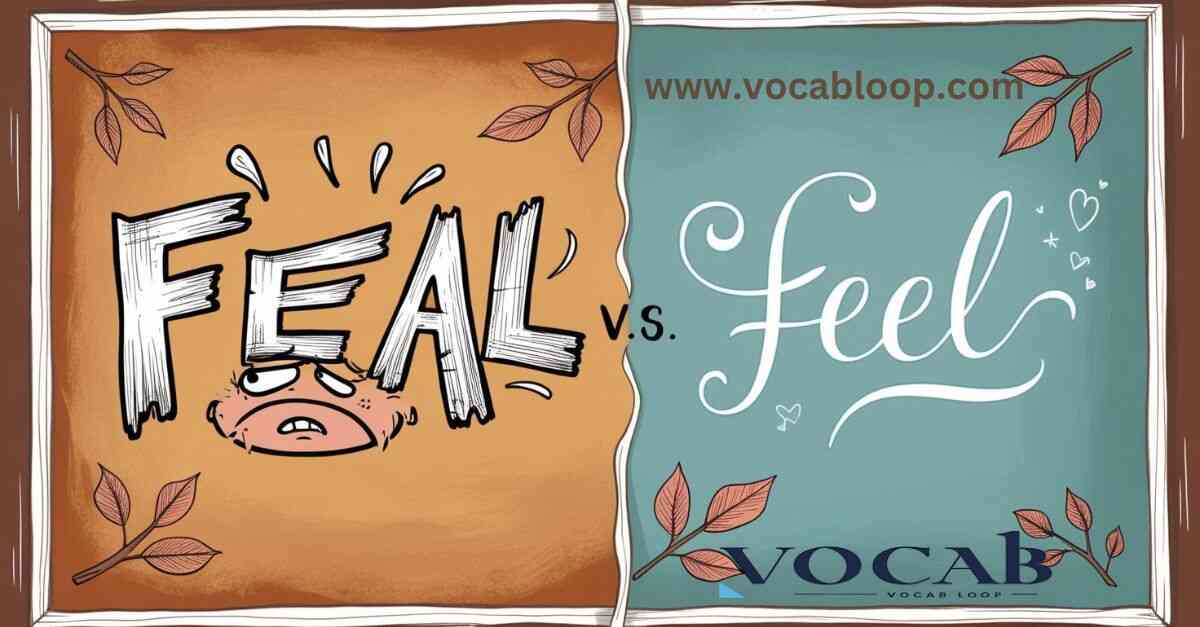The confusion between feal vs feel isn’t just a matter of spelling; it’s a window into the evolving nature of language itself. In our modern era of rapid communication, understanding these subtle differences can make or break your message.
As we delve into this topic, you’ll discover surprising historical connections and gain valuable insights into the richness of English vocabulary.
“The difference between the right word and the almost right word is the difference between lightning and a lightning bug.” – Mark Twain
This quote perfectly encapsulates why mastering Language Tools like “feal” and “feel” is crucial for effective communication.
What Does the Word “Feal” Mean?

The word “feal“ is an archaic adjective meaning faithful or loyal
It was used to describe someone who is trustworthy and devoted. Though rarely used in modern English, it has its roots in Middle English and Old French.
Archaic Definitions and Usage
In its heyday, “feal” primarily functioned as an adjective, meaning:
- Loyal
- Faithful
- Devoted
These definitions align closely with our modern understanding of loyalty and dedication.
Regional Variations and Dialectal Use
While “feal” has largely fallen out of common usage, it occasionally surfaces in certain regional dialects, particularly in parts of Scotland and Northern England. In these areas, you might still hear phrases like “a feal friend” to describe a loyal companion.
Common Misconceptions “feal” vs “feel”
Many people mistakenly believe “feal” is simply a misspelling of “feel.” This misconception stems from their similar pronunciation and the rarity of “feal” in modern texts.
Origins of the Word “Feal”
The etymology of “feal” offers a fascinating glimpse into linguistic history.
Etymology and Linguistic Roots
“Feal” traces its roots to:
- Old English: “fēole” meaning faithful
- Old French: “feal” or “feeil”
- Medieval Latin: “fidēlis” meaning faithful
This word is a testament to the complex tapestry of influences that shaped the English language.
Historical Context and Evolution
The use of “feal” peaked during the Middle Ages, particularly in feudal contexts where loyalty was paramount. Over time, as societal structures changed, the word gradually fell out of favor.
Related Words in Other Languages
Several languages have words related to “feal”:
| Language | Related Word | Meaning |
| French | Fidèle | Faithful |
| Spanish | Fiel | Loyal |
| Italian | Fedele | Faithful |
This linguistic family tree showcases the interconnectedness of European languages.
What Does the Word “Feel” Mean?

The word “feel“ is a verb that means to perceive or experience something through the senses, especially touch.
It can also refer to experiencing emotions or sensations, such as happiness or pain. As a noun, “feel” can describe the tactile quality of something or an emotional impression.
Multiple Definitions Across Parts of Speech
As a verb:
- To perceive through touch
- To experience an emotion or sensation
- To believe or think
As a noun:
- A sensation experienced
- An atmosphere or mood
Psychological and Emotional Connotations
“Feel” plays a crucial role in expressing emotional states and empathy. It’s a cornerstone of emotional intelligence vocabulary.
Tactile and Sensory Meanings
In its most basic form, “feel” relates to our sense of touch, allowing us to describe physical sensations.
Origins of the Word “Feel”

The journey of “feel” through linguistic history is equally intriguing.
Germanic Roots and Old English Connections
“Feel” stems from:
- Old English: “fēlan”
- Proto-Germanic: “*fōlijaną”
These ancient roots highlight the word’s longevity in the English language.
Semantic Shift Over Time
While the core meaning of “feel” has remained relatively stable, its usage has expanded to encompass a wider range of sensory and emotional experiences.
Influence on Modern English Vocabulary
“Feel” has spawned numerous related terms and phrases:
- Feeling
- Feeler
- Feel-good
- Touchy-feely
“Feal” vs “Feel”: The Crucial Differences

Understanding the distinctions between these Homophones is key to using them correctly.
Grammatical Function
- “Feal”: Primarily an adjective (rarely used as a verb)
- “Feel”: Versatile, functioning as both a verb and a noun
Contextual Usage
“Feal” is limited to historical or highly specialized contexts, while “feel” is ubiquitous in everyday language.
Common Errors and How to Avoid Them
Mistake: “I feal happy today.” Correction: “I feel happy today.”
To avoid errors, remember that in modern English, “feel” is the correct choice in almost all situations.
Pronunciation Guide
While these words look similar on paper, their pronunciation can vary.
Regional Variations in “Feel” Pronunciation
- Standard American: /fiːl/
- British Received Pronunciation: /fiːl/
- Scottish: Can sound closer to /fil/
How “Feal” Might Be Pronounced (If Encountered)
If you encounter “feal” in historical texts or regional dialects, it’s typically pronounced similarly to “feel”: /fiːl/
Tips for Clear Communication feal vs feel
When in doubt, opt for “feel” in speech to avoid confusion. If you must use “feal” in a historical context, consider providing a brief explanation.
Synonyms and Related Words
Expanding your vocabulary with synonyms can enhance your writing and speaking skills.
Feal (adj.)
- Loyal
- Faithful
- Devoted
- True
- Steadfast
Feal (v.) – Rare Usage
- Hide
- Conceal
- Obscure
Feel (verb)
- Sense
- Perceive
- Experience
- Intuit
- Palpate
Feel (noun)
- Sensation
- Impression
- Atmosphere
- Vibe
- Texture
Examples in Context

Historical Literature Featuring “Feal”
From Sir Walter Scott’s “Ivanhoe” (1819):
“I am a feal vassal to the king.”
This usage exemplifies the traditional meaning of “feal” as loyal or faithful.
Modern Uses of “Feel” in Various Contexts
- Emotional: “I feel ecstatic about the promotion.”
- Physical: “The fabric feels smooth against my skin.”
- Intuitive: “I feel like something big is about to happen.”
Potential Misuses and How to Correct Them
Incorrect: “The feal of the wind on my face was refreshing.” Correct: “The feel of the wind on my face was refreshing.”
The Impact of “Feel” in Modern Language
“Feel” has become an integral part of how we express ourselves in the 21st century.
Emotional Intelligence and “Feeling” Words
The ability to articulate feelings is crucial for emotional intelligence. “Feel” and its derivatives play a central role in this linguistic landscape.
“Feel” in Idiomatic Expressions
- “Feel under the weather”
- “Feel at home”
- “Feel out of place”
These idioms enrich our language and allow for nuanced expression.
Digital Communication and the Importance of “Feel”
In the age of texting and social media, “feel” has taken on new forms:
- “All the feels”
- “I’m feeling this”
- Emoji usage to convey feelings
When to Use “Feal” (If Ever)

While “feal” is largely obsolete, there are rare instances where it might be appropriate.
Historical Writing and Period Pieces
When crafting dialogue or narration set in medieval or early modern periods, “feal” can add authenticity.
Specific Dialects or Regional Language
In representations of certain Scottish or Northern English dialects, “feal” might appear.
Artistic or Poetic License
Poets or novelists might employ “feal” for its archaic flavor or to evoke a specific mood.
Mastering “Feel” in Writing and Speech
Honing your use of “feel” can significantly improve your communication skills.
Techniques for Effective Use
- Be specific about emotions: “I feel anxious” is more precise than “I feel bad”
- Use “feel” to create sensory descriptions in writing
- Employ “feel” to express opinions tactfully: “I feel that this approach could be improved”
Common Pitfalls to Avoid
- Overuse of “feel” in formal writing
- Confusing “feel” (verb) with “feeling” (noun)
- Using “feel” when more precise verbs are available
Exercises to Improve Understanding and Usage
- Journal your emotions using “feel” in varied contexts
- Practice describing textures using “feel” as both a verb and noun
- Rewrite sentences to replace “feel” with more specific verbs or adjectives
FAQ’s
What does “feal” mean, and where does it come from?
“Feal” is an old English word meaning faithful or loyal, originating from Old French and Medieval Latin roots. It was commonly used in the Middle Ages to describe devotion or trustworthiness.
How does the usage of “feal” differ from “feel”?
“Feal” is primarily an archaic term, rarely used today, while “feel” is a versatile modern word used in everyday language to describe sensations, emotions, or physical touch.
Why has “feal” become obsolete?
The word “feal” became obsolete as societal and linguistic trends shifted, with other words like “faithful” and “loyal” replacing it in common usage over time.
Can “feal” be used in writing today?
Yes, “feal” can still be used for artistic, poetic, or historical purposes, particularly to evoke a medieval or classical feel in dialogue or narration.
What are common mistakes when using “feal” and “feel”?
People sometimes confuse “feal” with “feel” due to similar pronunciation, but “feel” should be used in modern contexts. For example, saying, “I feal happy” is incorrect; the correct phrasing is, “I feel happy.”
Conclusion
The journey of “feal” vs “feel” encapsulates the dynamic nature of language. While “feal” has largely retreated into the annals of linguistic history, “feel” continues to evolve and adapt to our changing communication needs.
Understanding these nuances not only improves our grammar but also enriches our appreciation for the complex tapestry of English. As we navigate the ever-changing landscape of language, let’s embrace the precision and power that comes from choosing the right word.

Alex Hormozi is a seasoned blogger at Vocab Loop, known for his deep insights into language, vocabulary, and grammar. With years of experience in writing, Alex shares practical tips and effective strategies to help readers improve their linguistic skills and enhance their writing abilities.

